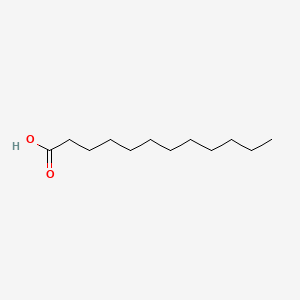lauric acid
lauric acid is a lipid of Fatty Acyls (FA) class. Lauric acid is associated with abnormalities such as Infection, Renal tubular disorder, Hypertensive disease, Obesity and Mycoses. The involved functions are known as Transcription, Genetic, Signal Transduction, Mutation, metaplastic cell transformation and Anabolism. Lauric acid often locates in Skin, Plasma membrane, Cytoplasmic matrix, Body tissue and Palmar surface. The associated genes with lauric acid are Gene Family, SLC33A1 gene, Homologous Gene, Open Reading Frames and P4HTM gene. The related lipids are Fatty Acids, Oleic Acids, Palmitates, Stearates and 9,11-linoleic acid.
References related to abnormalities published in Others
| PMID | Journal | Published Date | Author | Title |
|---|---|---|---|---|
| 9281597 | Mol. Pharmacol. | 1997 | Kroetz DL et al. | Developmentally regulated expression of the CYP4A genes in the spontaneously hypertensive rat kidney. |
| 14670847 | Circ. Res. | 2004 | Jiang M et al. | Smooth muscle--specific expression of CYP4A1 induces endothelial sprouting in renal arterial microvessels. |
| 20035028 | Am. J. Physiol. Heart Circ. Physiol. | 2010 | Simpkins AN et al. | Soluble epoxide hydrolase inhibition modulates vascular remodeling. |
| 15611369 | Circulation | 2005 | Gainer JV et al. | Functional variant of CYP4A11 20-hydroxyeicosatetraenoic acid synthase is associated with essential hypertension. |
| 16120613 | J. Biol. Chem. | 2005 | Kandel S et al. | Cloning, functional expression, and characterization of CYP709C1, the first sub-terminal hydroxylase of long chain fatty acid in plants. Induction by chemicals and methyl jasmonate. |
| 17034417 | FEMS Yeast Res. | 2007 | Clément M et al. | Whey-derived free fatty acids suppress the germination of Candida albicans in vitro. |
| 22155833 | Antimicrob. Agents Chemother. | 2012 | Fischer CL et al. | Antibacterial activity of sphingoid bases and fatty acids against Gram-positive and Gram-negative bacteria. |
